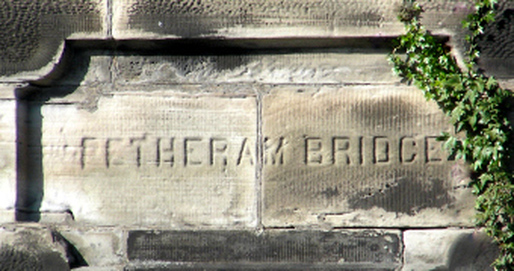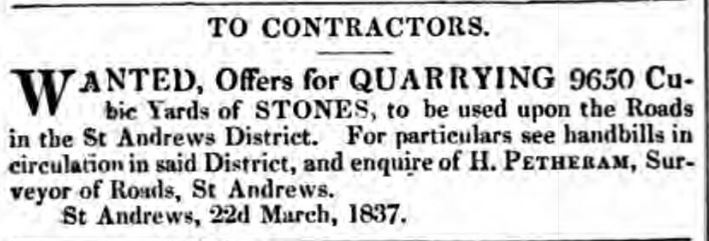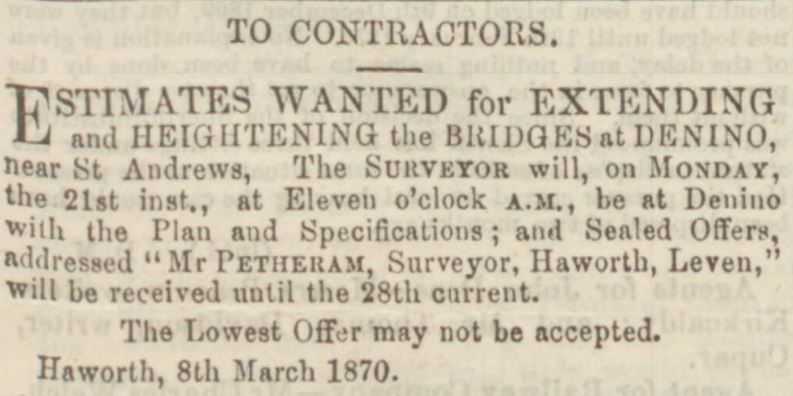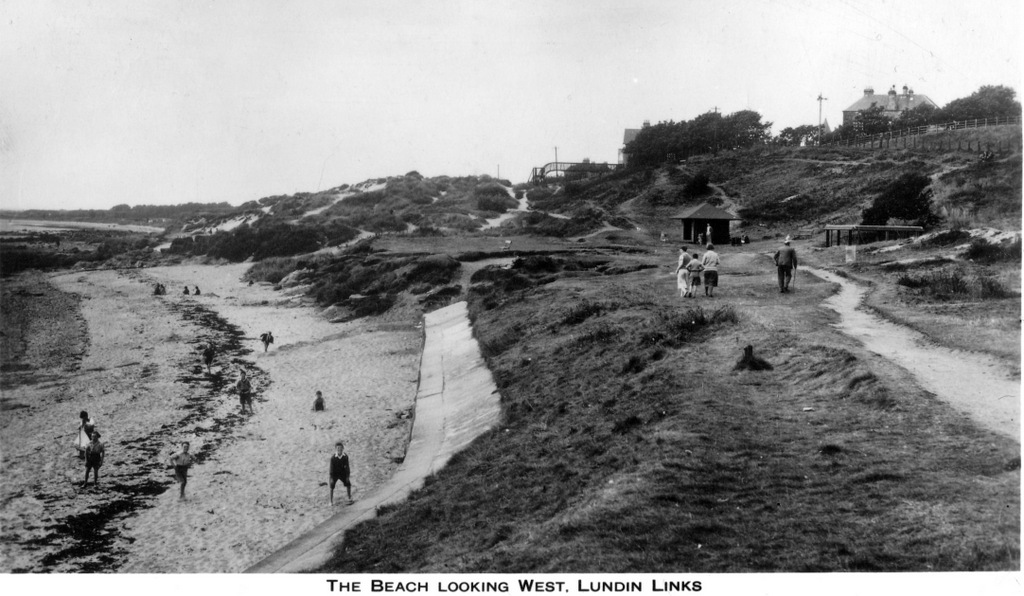|
The view below of Gibson Place in St Andrews was taken from the Petheram Railway Bridge, built in 1887 and dismantled soon after the last train ran over it in 1969. The bridge was named after the St Andrews District Road Surveyor Henry Petheram. The bridge might be gone, but the name endures in the 'Petheram Bridge Car Park' in the town. Henry was born in Somerset in 1809 but was working in St Andrews as a road surveyor by the mid-1830s. There he met Janet Gibson and they married in 1837 at Foodie before setting up home at Drummochy House close to Largo Harbour. He would spend the next 50 years living in Largo and Lundin Links, the last of his children would still be there in the 1930s. The job of Surveyor of Roads was a high-profile role which require much travel around the district (presumably much on horse-back). The newspaper archives are full of advertisements for works such as bridge building, hill flattening, quarrying and road building overseen by Petheram. In fact his movements can be tracked through these notices - see below how Petheram's whereabouts change from St Andrews, to Drummochy, to Lundin Mill and finally to Haworth (the house next to Homelands). Henry and Janet Petheram had at least 10 children, the youngest of which was born when Henry was aged 50. Henry was in the 1860s the Chair of Largo Field Naturalists Society and was involved with Largo Horticulturists Society. He died on 9 June 1886 and was Head Road Surveyor at the time of his death (aged 77). At the meeting of the St Andrews Road Trustees some days later, when his death was reported, the trustees expressed their regret and their sense of value of his services, noting that he "was held in the highest esteem by all with whom he came in contact". Attention was to be given to filling the vacancy for his job at the next meeting - more on that in the next post.
0 Comments
Although originally named "Earnest Cottage", the house at the junction of Largo Road and Cupar Road, began to morph into 'Ernest Cottage' quite soon after the death of the earliest recorded proprietor, Captain John Beatson. By 1848, the Petheram family were living at the cottage. They lived there for around 20 years. Henry Petheram was Inspector of Roads (more on him to come in a future post). Born in Somerset in 1809, he married Janet Gibson of St Andrews in 1837 and they initially lived in Drummochy House overlooking the harbour at Lower Largo before moving to Earnest Cottage. They had a large family and many birth notices appear in the newspaper archives, some of which record the place of birth as 'Ernest Cottage' - the beginnings of the house's name evolving from its original spelling. The Petherams moved to 'Haworth' off Leven Road (next to Homelands) around 1860 and soon the Weir family were living at Ernest Cottage. John Weir was coal master at Lundin colliery, meaning that he was in overall charge of that colliery at the time (1860s). In 1871 the cottage was advertised for let and the following year it was put up for sale (see first two adverts below). By this time the imposing Lundin Mill Farm House had been built in front of the cottage (see image at the foot of this post). It seemed to be generally known as 'Ernest Cottage' but occasionally the original 'Earnest' spelling would still be used (see 1898 example - third below). Long-time Lundin Mill baker, Robert Tullis, retired to Ernest Cottage from the bakery down by the Keil and spent much of the 1890s there, before passing away at the cottage in May of 1898. The early years of the twentieth century saw rooms in the cottage let to summer visitors (it was around that time that the image at the top of this blog post was taken). Since then the cottage has changed in appearance significantly and its very early origins and interesting history are now well disguised.
The house on the left in the images below (top view from the early twentieth century, lower view a century later) is Earnest Cottage. Although the name has morphed over the years into 'Ernest Cottage', the original name was spelled 'Earnest' and, through newspaper archives, the origins of that name and the cottage itself can be tracked down. Back in 1818, a man named John Beatson was captain of a ship named 'The Brig Earnest' (see advert below from the 18 March Public Ledger and Daily Advertiser). This ship had been built in Leith in 1804 by Menzies and Goalen as a 12 gun 80 x 23 ft gun-brig for the Royal Navy. Sold by the Navy in 1816, the Earnest became cargo ship operating out of London. John Beatson had been born in Methil in 1779 but his mother, Elizabeth Guthrie, was from Largo Parish. When Captain Beatson retired from his career at sea, he returned to his roots and set up home at the junction of Largo Road and Cupar Road, naming his house after the ship which he had captained. The cottage was built circa 1819. At what point John Beatson took ownership is unclear but by 1835 the Perthshire Courier reported that summer on the yield of his crops from the land adjoining Earnest Cottage. Beatson died on 28 December 1838 at the cottage at the age of 59. He was buried at the old Largo Churchyard alongside his parents, who had also returned to the parish of his mother's birth to end their days. Earnest Cottage is mentioned in the inscription on the gravestone. The property was put up for sale and a full description appeared in the Fife Herald of 6 June 1838 (below). It notes the cottage's "great facility for communication and travelling in every direction" with the coach service passing the house. Earnest Cottage must indeed have been an "eligible and delightful residence" in its heyday.
The above postcard was posted in 1937 and was produced for 'Young, Stationer and Newsagent, Lundin Links'. It shows all ages out enjoying the seaside before the outbreak of World War Two and before the building of the coastal defences. The shelter and the platform, seen to the right of centre, are evidence of the popularity of this spot and the willingness to invest in facilities for visitors and to put on events. I imagine the Largo and District Silver Band playing here and excursion groups setting up base here for their day by the sea. Known as Massney Braes locally, this area has been popular over many decades, with pathways and latterly play park facilities.
A bit of a commotion going on opposite the shops on Leven Road, Lundin Links in September 1993 in the above photo. The Fife Scottish double decker bus had broken down and an orange towing bus was summoned to take it away (see close-up below). Note the 'Caution - On Tow' sign in the downstairs back window of the bus. Fife Scottish always painted their tow wagons orange to make them noticeable. Fife Scottish has been purchased by Stagecoach in 1991 and the old red and cream livery replaced with the Stagecoach corporate colours shown above.
More interesting perhaps are the shops in the background. The pink-fronted shop next to the Royal Bank of Scotland was called 'Pretty Details' and sold gifts including dried flower arrangements. Both the newsagent (on the other side of Pretty Details) and the Post Office (on the far corner) had prominent cigarette advertising (Silk Cut and Benson and Hedges respectively), as was common for corner shops and newsagents up until the mid-1990s. |
AboutThis blog is about the history of the villages of Lundin Links, Lower Largo and Upper Largo in Fife, Scotland. Comments and contributions from readers are very welcome!
SearchThere is no in-built search facility on this site. To search for content, go to Google and type your search words followed by "lundin weebly". Categories
All
Archives
July 2024
|



















 RSS Feed
RSS Feed
